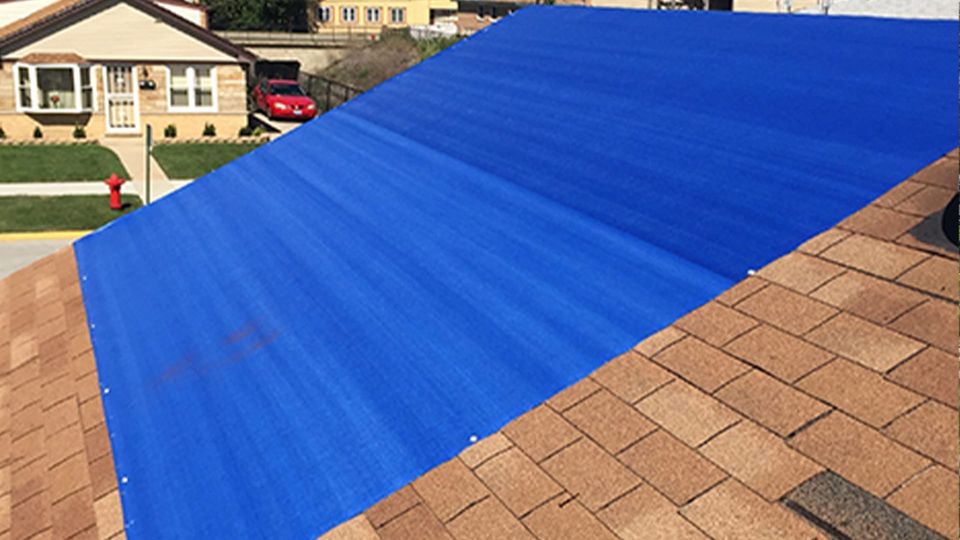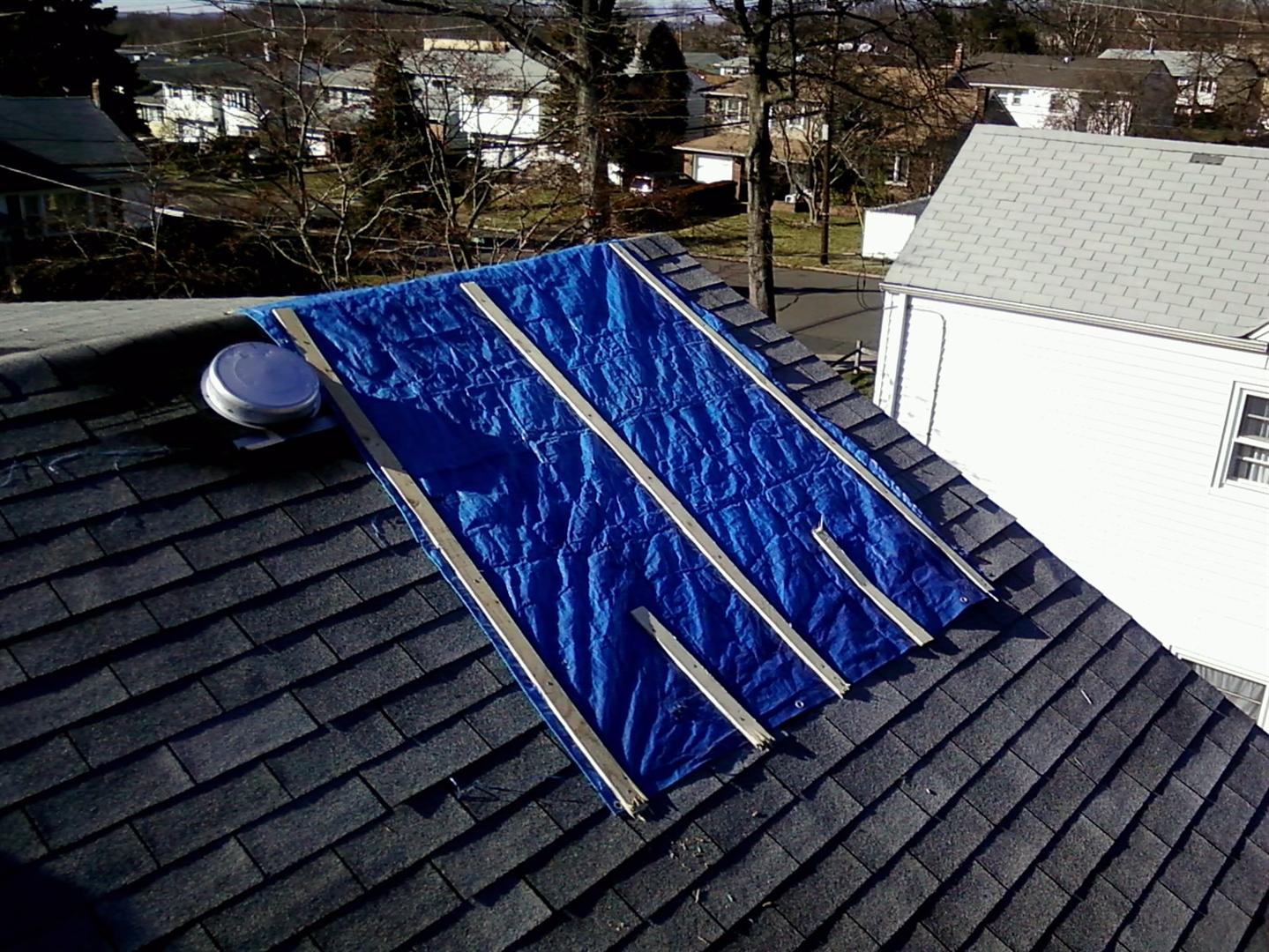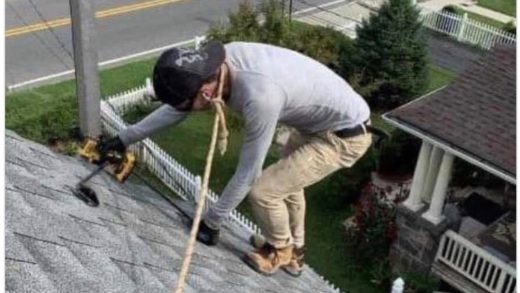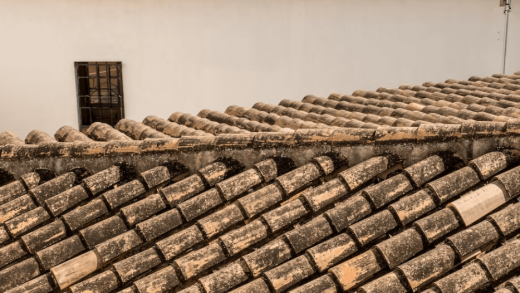
How to Tarp a Roof
In extreme weather conditions, one of the most important steps you can take to protect your home is to tarp your roof. By properly tarping your roof, you can prevent water damage, leaks, and further deterioration. Whether you are dealing with a damaged roof or preparing for a storm, learning how to tarp a roof is a skill every homeowner should have.
To begin the tarping process, you will need a few essential tools and supplies. Make sure you have a sturdy ladder, a tarp that is large enough to cover the damaged area, ropes or bungee cords for securing the tarp, and a broom or brush for removing debris from the roof surface. Additionally, it’s important to wear appropriate safety gear, such as gloves and non-slip shoes, to reduce the risk of accidents.
Start by assessing the damage to your roof and identifying the areas that need to be covered. Look for missing or damaged shingles, cracks, or holes where water can seep through. It’s crucial to address these areas first and prioritize the tarping process accordingly. Once you’ve determined the scope of the damage, you can proceed with the tarp installation.
Before laying the tarp, make sure the roof surface is clean and free of debris. Use a broom or brush to remove any leaves, branches, or dirt that may prevent the tarp from adhering properly. This step is vital to ensure a secure and watertight seal. Once the roof is clean, carefully unfold the tarp and position it over the damaged area, making sure it extends beyond the damaged section by at least a few feet.
Assess the Damage
To tarp a roof effectively, it’s important to first assess the damage. Here’s how:
- Inspect the Entire Roof: Begin by carefully examining the entire roof to identify any visible damage or signs of leaking. Look for missing or damaged shingles, cracked tiles, or areas where the roof may be sagging or deteriorating.
- Check for Leak Stains: Look inside the house for any water stains on the ceiling or walls, which may indicate a leak. This will help you identify the areas of the roof that need immediate attention.
- Examine Flashing and Ventilation: Inspect the flashing around chimneys, vents, and skylights, as well as the ventilation systems on the roof. Damage to these areas can also contribute to leaks and water damage.
- Assess Gutters and Downspouts: Check the gutters and downspouts for any debris or blockages that could be preventing proper drainage. Clogged gutters can cause water to overflow and damage the roof.
- Look for Signs of Mold or Rot: Keep an eye out for any signs of mold, rot, or decay on the roof. These issues can weaken the structure and compromise its integrity.
By thoroughly assessing the damage, you’ll have a better understanding of the repairs or reinforcements needed before tarping the roof.
Gather the Necessary Tools
Before you begin the task of tarping your roof, it’s important to gather all the necessary tools. Having the right tools on hand will make the tarping process much smoother and more efficient. Here are the essential tools you’ll need:
- Tarp: Make sure you have a strong and durable tarp that is large enough to cover the damaged area of your roof.
- Bungee cords or ropes: These will be used to secure the tarp to the roof. Make sure you have enough to create a secure and tight fit.
- Ladder: A sturdy ladder is essential for safely accessing your roof. Make sure the ladder is in good condition and placed on a stable surface.
- Gloves: Protect your hands by wearing gloves while handling the tarp and securing it to the roof.
- Nails or staples: Depending on the type of roof you have, you may need nails or staples to secure the tarp in place.
- Tape measure: Use a tape measure to accurately measure the size of the damaged area and ensure your tarp is large enough.
- Utility knife: A utility knife will come in handy for cutting the tarp to the correct size and making any necessary adjustments.
By gathering all these necessary tools in advance, you’ll be well-prepared to tarp your roof and protect it from further damage. Remember to always prioritize safety and take precautions while working at heights.
Choose the Right Tarp
When it comes to protecting your roof, choosing the right tarp is crucial. Not all tarps are created equal, and selecting the wrong one can result in an ineffective barrier against the elements.
Here are some factors to consider when choosing a tarp:
- Material: Look for a tarp made of durable and waterproof material. Common options include polyethylene, vinyl, and canvas. Make sure the tarp is UV resistant to prevent sun damage.
- Size: Measure the size of your roof to determine the appropriate tarp dimensions. It’s better to choose a slightly larger tarp than one that is too small, as you can always secure the excess material.
- Thickness: The thickness of the tarp, usually measured in mils, determines its durability and ability to withstand harsh weather conditions. Thicker tarps are generally more reliable for long-term use.
- Grommets: Grommets are the metal rings along the edges of the tarp that are used for securing it in place. Look for a tarp with reinforced grommets for added strength and stability.
- Color: While color might not seem like an important factor, it can affect the performance of the tarp. Light-colored tarps reflect sunlight and heat, helping to keep the underlying area cooler.
Remember, a properly chosen tarp is essential for effectively protecting your roof!
Measure the Roof
Before you begin tarping your roof, it’s important to accurately measure the area you need to cover. This will ensure that you get a tarp that is the right size and provides complete protection.
To measure your roof, follow these steps:
- Gather your materials: You will need a measuring tape, a pen or marker, and a piece of paper to record your measurements.
- Determine the shape of your roof: Is it a simple rectangle, or does it have multiple sections or slopes?
- Measure the length and width: Starting at one edge of the roof, use your measuring tape to measure the length of the roof. Write down this measurement. Then, measuring from the same edge, measure the width of the roof and record this measurement as well.
- Calculate the total area: Multiply the length and width measurements together to get the total square footage of your roof.
- Add extra for overhang: To ensure complete coverage, add a few feet to each side of your measurements to account for any overhang or sloping.
Once you have your measurements, you can use them to determine the size of the tarp you will need. Make sure to choose a tarp that is large enough to cover the entire roof and provide a few extra feet of overlap for secure fastening.
By accurately measuring your roof, you can ensure that you get the right size tarp and provide ultimate protection for your roof.
Clean the Roof Surface
Before you can tarp a roof, it is important to clean the roof surface to ensure proper adhesion of the tarp and to avoid any damage to the tarp or the roof itself.
Here’s how to clean the roof surface:
- Safety first: Before you begin, make sure you have the necessary safety equipment, such as gloves, goggles, and sturdy shoes.
- Remove debris: Start by removing any debris from the roof, such as leaves, sticks, or other loose materials. Use a broom or a leaf blower to clear away the debris.
- Sweep the roof: Once the larger debris has been removed, use a soft-bristle broom to sweep the roof surface. Pay close attention to any areas where dirt or moss may have accumulated.
- Inspect for damage: While you clean the roof, take the opportunity to inspect for any signs of damage, such as cracked or loose shingles, damaged flashing, or other issues that may need to be addressed before tarping the roof.
- Remove loose nails: If you come across any loose nails or fasteners, be sure to remove them carefully. Hammer in any protruding nails to ensure a smooth surface for the tarp.
- Wash the roof: If the roof surface is especially dirty or stained, you may want to consider washing it with a gentle cleaning solution and a soft brush. Rinse thoroughly with water to remove any soap residue.
By cleaning the roof surface before tarping, you’ll help ensure a secure and long-lasting tarp installation.
Remove Loose or Damaged Shingles
Before you begin tarping a roof, it’s important to assess the condition of the shingles. Loose or damaged shingles can lead to leaks and further damage during the tarping process, so it’s essential to address these issues before moving forward.
To remove loose shingles, start by carefully lifting up each shingle to inspect the condition underneath. If you notice any nails that have popped up or shingles that are cracked or curling, use a pry bar to remove the nails and gently lift off the damaged shingles.
If you encounter any stubborn or stuck shingles, you can use a heat gun or a hairdryer on a low setting to soften the adhesive and make the removal process easier. Just be careful not to overheat or damage the shingles in the process.
Once you’ve removed any loose or damaged shingles, make sure to clean up any debris or loose nails from the roof surface. This will help ensure a smooth and secure tarping process.
Note: If you are unsure about removing shingles or if the roof is severely damaged, it’s best to consult a professional roofing contractor for assistance.
By following these steps, you’ll ensure a solid foundation for tarping your roof and provide ultimate protection for your home.
Install Roofing Felt
Roofing felt is an essential layer that provides an additional barrier between the roof and the tarp. It helps to protect the roof from moisture, reduces the risk of leaks, and adds an extra layer of insulation. Follow these steps to install roofing felt:
- Start by cleaning the roof surface thoroughly. Remove any debris, nails, or other obstructions that may interfere with the installation. This ensures a smooth and even surface for the roofing felt.
- Measure the dimensions of the roof to determine the amount of roofing felt needed. It’s recommended to use a roll of roofing felt that covers the entire roof surface.
- Unroll the roofing felt on the roof, starting at one corner. Make sure to align the edge of the felt with the edge of the roof. Secure the felt in place using roofing nails or staples, placing them every 6 to 8 inches along the edges and about 12 inches apart in the middle.
- Continue unrolling the roofing felt across the roof surface, keeping it taut and wrinkle-free. Overlap each row of felt by 2 to 4 inches to ensure complete coverage. Secure each row with nails or staples as before.
- Trim any excess roofing felt using a utility knife, ensuring a neat and flush finish along the edges of the roof. Be careful not to cut into the roof structure underneath.
- Inspect the entire roofing felt installation for any gaps, wrinkles, or loose sections. Make any necessary adjustments or repairs before proceeding to the next step.
Once the roofing felt is properly installed, you can proceed to tarping the roof for ultimate protection. The roofing felt provides an added layer of defense, making your tarping job more effective and ensuring the long-term durability of your roof.
Secure the Tarp at the Corners
Once you have properly positioned the tarp over the roof, it is important to secure it at the corners to ensure maximum protection. Follow these steps to secure the tarp at the corners:
- Fold the tarp: Begin by folding the tarp diagonally from one corner to the opposite corner. This will help create a secure and tight fit when securing the corners.
- Place heavy objects: After folding, place heavy objects such as bricks or sandbags on the folded corners. This will provide stability and prevent the tarp from blowing away during strong winds.
- Secure with ropes or bungee cords: Attach ropes or bungee cords to the corners, securing them tightly. Make sure the ropes or cords are securely fastened to prevent any slack in the tarp.
- Adjust and tighten: Once the corners are secured, adjust and tighten the tarp if necessary. This will ensure that it is taut and properly protecting the roof from any potential damages.
Remember to check and secure the tarp regularly, especially after heavy rain or wind, to ensure it remains in place and provides optimal protection for your roof.
Attach the Tarp to the Roof
Once you have properly positioned the tarp over the damaged area of the roof, it is time to secure it in place. Follow these steps to attach the tarp securely:
- Gather the necessary tools and materials: Before you begin, make sure you have the following items on hand:
- Tarp
- Roofing nails
- Hammer
- Bungee cords or ropes
- Attach the tarp with roofing nails: Starting at one corner of the tarp, use roofing nails to secure the tarp to the roof sheathing. Space the nails about every 12 inches along the edges of the tarp. Be careful not to hammer the nails too close to the edge, as this may cause the tarp to tear.
- Secure the tarp with bungee cords or ropes: To provide additional stability and prevent the wind from lifting the tarp, use bungee cords or ropes to secure the tarp to the roof. Attach one end of the cord or rope to a corner of the tarp and the other end to a sturdy anchor point, such as a chimney or a heavy object on the ground. Repeat this process for each corner of the tarp and any other areas where you feel additional support is necessary.

By following these steps, you can ensure that the tarp is securely attached to the roof, providing the ultimate protection against further damage. Remember to periodically check the tarp and make any necessary adjustments or repairs to maintain its effectiveness.
Ensure Proper Drainage
When tarping a roof, it’s important to ensure proper drainage to prevent water buildup and potential damage. Here are some steps to follow:
- Start by inspecting the roof to identify any areas where water may accumulate.
- Clear the roof of any debris that may obstruct water flow.
- Position the tarp in a way that allows water to flow freely towards the gutters or downspouts.
- Ensure that the tarp is stretched tight and secured properly to prevent sagging or pooling.
- If necessary, use additional materials such as boards or sandbags to create a slight slope for better drainage.
- Regularly check the tarp to ensure it hasn’t shifted or become loose, as this can impact the effectiveness of drainage.
By following these steps, you can help protect your roof from water damage and ensure proper drainage when tarping it.
Create Overlaps to Prevent Leaks
When tarping a roof, it is crucial to create overlaps to ensure ultimate protection against leaks. Overlaps act as an additional layer of defense, preventing water from seeping through the tarp and causing damage to the underlying structure. Here are a few steps to follow when creating overlaps:
- Start by positioning the first tarp at the bottom edge of the roof, ensuring that it covers the desired area.
- Secure the first tarp in place using nails or tarp clips, making sure it is stretched taut and flat.
- Overlap the next tarp over the edge of the first tarp by at least 6 inches.
- Secure the second tarp in place, again ensuring it is flat and taut.
- Repeat this process for each subsequent tarp, overlapping each one over the previous tarp by at least 6 inches.
- Continue until the entire roof is covered with overlapping tarps.
Creating overlaps in this manner will help create a watertight barrier on the roof, minimizing the risk of leaks and ensuring maximum protection. It is important to ensure that each tarp is securely fastened and that the overlaps are tightly sealed to prevent any water from seeping through.
Secure the Edges of the Tarp
After you have properly positioned the tarp on the roof, it is crucial to secure the edges to ensure maximum protection. The edges of the tarp are the most vulnerable areas, as wind and other elements can easily lift or tear them. Follow these steps to securely fasten the edges of the tarp:
- Use bungee cords or ropes: Attach bungee cords or ropes to the grommets or eyelets located along the edges of the tarp. Make sure to evenly space out the cords or ropes to distribute the tension equally.
- Tie knots: Secure the bungee cords or ropes to sturdy anchor points, such as the roof vents or chimneys, by tying knots. Ensure the knots are tight and won’t slip or come undone under pressure.
- Apply adhesive or tape: In addition to the bungee cords or ropes, consider applying adhesive or tape along the edges of the tarp. This extra layer of reinforcement will provide added strength and prevent the tarp from lifting or flapping in strong winds.
- Check for tightness: Once you have secured all the edges, check for any loose areas or gaps where wind or water could still penetrate. If necessary, make adjustments and tighten the ropes or cords further to ensure a snug fit.
Remember, properly securing the edges of the tarp is crucial for ultimate protection of your roof. Take the time to make sure the tarp is tightly fastened and that there are no weak spots that could compromise its effectiveness. By following these steps, you can have peace of mind knowing your roof is well-protected.
Reinforce the Tarp with Additional Fasteners
When tarping a roof, it’s important to secure the tarp in place to ensure maximum protection. In addition to using the recommended fasteners, there are a few additional steps you can take to reinforce the tarp and prevent it from coming loose.
- Use bungee cords or rope: In addition to nails or staples, you can also use bungee cords or rope to secure the tarp to the roof. This will provide added support and help keep the tarp in place during strong winds or heavy rain.
- Create overlapping layers: If possible, consider overlapping multiple tarps on the roof. This will create a stronger barrier against water and debris and reduce the chances of the tarp tearing or coming loose.
- Place sandbags or heavy objects: Along the edges of the tarp, you can place sandbags or other heavy objects to weigh it down. This will help prevent the tarp from lifting up or blowing away in strong winds.
- Inspect and tighten regularly: Once the tarp is in place, regularly check it for any signs of loosening or damage. If you notice any areas that need additional reinforcement, secure them promptly to ensure the tarp remains effective.
By reinforcing the tarp with additional fasteners, creating overlapping layers, adding weight along the edges, and regularly inspecting and tightening, you can maximize the protection provided by the tarp and enhance its durability.
Check for Any Gaps or Weak Points
Before you begin tarping your roof, it’s important to check for any gaps or weak points that could potentially compromise the effectiveness of the tarp. These gaps or weak points may allow water or debris to penetrate the tarp and cause further damage to your roof.
Start by visually inspecting the roof for any visible gaps, cracks, or damaged areas. Look for missing or loose shingles, damaged flashing, or any other signs of vulnerability. These weak points can serve as entry points for water and debris, so it’s crucial to address them before tarping.
If you notice any gaps or weak points, make sure to repair them before applying the tarp. Use roofing cement or other appropriate sealants to seal any cracks or gaps in the roof surface. Replace any missing or damaged shingles, and secure loose flashing.
Additionally, check the edges of the roof to ensure that there are no lifted or damaged edges. These edges can create spaces for water or debris to get underneath the tarp. If you find any lifted edges, use roofing nails or screws to secure them back in place.
Keep in mind that properly securing the tarp is essential for its effective protection. By taking the time to check for any gaps or weak points on your roof before tarping, you can ensure that the tarp will provide ultimate protection against the elements.
Inspect and Maintain the Tarp Regularly
Once you have successfully tarped your roof, it is important to regularly inspect and maintain the tarp to ensure its effectiveness in protecting your roof. Here are some steps on how to inspect and maintain the tarp:
- Check for any tears or holes: Periodically examine the tarp for any signs of damage such as tears or holes. These can compromise the tarp’s ability to shield your roof from the elements. If you notice any damage, consider repairing or replacing the tarp.
- Remove debris: Clear any debris that may have accumulated on top of the tarp. Leaves, branches, or other objects can create pockets of water and cause the tarp to sag or tear. Use a broom or brush to gently sweep off any debris.
- Inspect the securing methods: Check the fasteners or ropes used to secure the tarp to the roof. Ensure that they are still tightly in place and that there are no signs of weakness or wear. Tighten any loose fasteners or replace worn-out ropes as needed.
- Monitor water pooling: Keep an eye on the tarp to make sure that water is not pooling on top of it. Pooling water can put unnecessary weight on the tarp and lead to leaks or damage. Use a long pole or broom to gently push the accumulated water off the tarp.
- Inspect surrounding areas: In addition to checking the tarp itself, assess the condition of the surrounding areas. Look for any signs of water leakage, structural damage, or mold growth. Address these issues promptly to prevent further damage to your roof.
By regularly inspecting and maintaining the tarp, you can extend its lifespan and ensure optimal protection for your roof. Remember that the tarp is a temporary solution, so it’s important to address any underlying roof issues as soon as possible.
Remove the Tarp When the Roof is Repaired
Once the necessary repairs have been made to your roof, it’s time to remove the tarp. Properly removing the tarp is just as important as installing it correctly, as it ensures that your roof is fully protected and allows for proper ventilation.
- Begin by carefully removing any fasteners that were used to secure the tarp to the roof. This may include nails, staples, or bungee cords.
- As you remove the fasteners, be cautious not to damage the roof or any underlying structures.
- Once all the fasteners are removed, slowly and gently lift one corner of the tarp. Take care not to pull too hard or too quickly, as this can cause the tarp to tear or damage the roof.
- If the tarp is stuck due to adhesion from moisture or debris, use a soft brush or broom to gently loosen it.
- Slowly continue to lift the tarp, working your way towards the opposite corner. Take your time and be patient to avoid any unnecessary damage.
- Once the tarp is completely removed, carefully fold it up and store it in a dry and secure location for future use.
- Inspect the roof for any remaining debris or damage that may require further attention. Clear away any dirt or debris and make any necessary repairs before fully securing the roof.
Removing the tarp after the roof has been repaired is an important step in the process. It ensures that the roof is fully protected and allows for proper ventilation. By following these steps, you can safely remove the tarp and restore your roof to its original condition.
Questions and answers:
What materials do I need to tarp a roof?
You will need a tarp, hammer, nails, ladder, rope, and possibly some plywood.
Can I tarp a roof by myself?
Yes, you can tarp a roof by yourself, but it is recommended to have someone assist you for safety reasons.
How do I measure the size of the tarp I need for my roof?
To measure the size of the tarp you need, measure the length and width of the area you want to cover and add a few extra feet on each side for overhang.
Do I need to remove the old shingles before tarping a roof?
If possible, it is recommended to remove the old shingles before tarping a roof for better protection and to prevent further damage.
What precautions should I take while tarping a roof?
While tarping a roof, it is important to wear proper safety gear, use caution when climbing ladders, and secure the tarp tightly to avoid it from blowing away.
What is the purpose of tarping a roof?
The purpose of tarping a roof is to provide temporary protection against leaks and further damage caused by heavy rain or storms. It is a quick and effective solution that can help prevent water from entering your home.
What materials do I need to tarp a roof?
To tarp a roof, you will need a tarp (preferably a heavy-duty one), roof brackets or planks, a ladder, a hammer, nails, rope or bungee cords, and a utility knife. These materials will help you securely fasten the tarp to your roof and ensure it stays in place.



